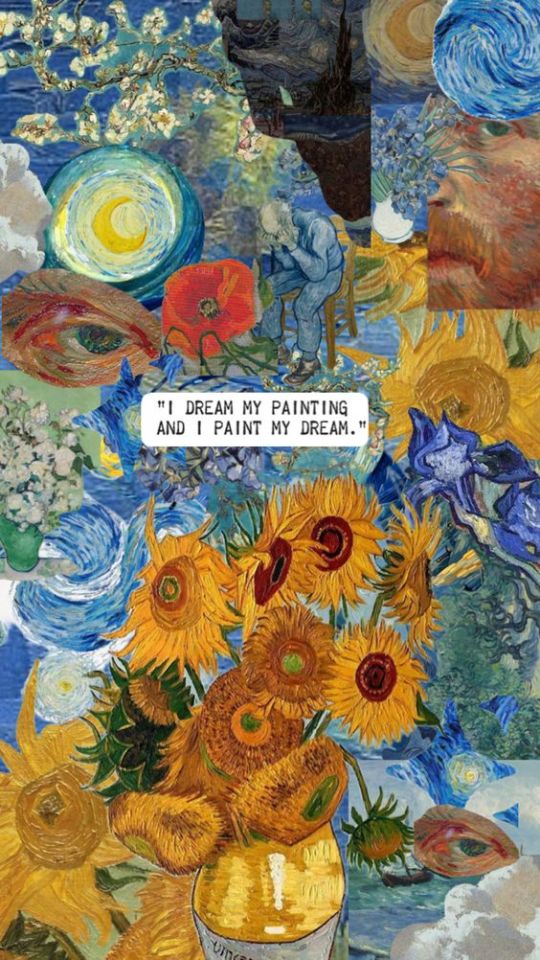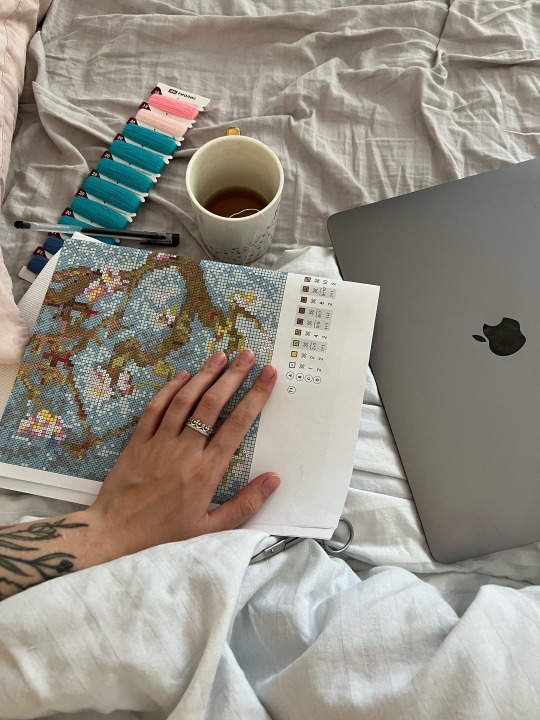#Vincent Willem van Gogh
Explore tagged Tumblr posts
Text
The thing about romanticizing the tortured artist trope is that it takes very serious health conditions, physical, mental, and emotional ones, and it turns it into a very empty aesthetic made for consumption. It takes a life story, and it turns it into a punch line, an easy way out to explain a lifelong struggle while having no regard for the person who actually lived it.
It’s a way of simplifying something so complex as a whole life story, take away the good parts, the artist’s talent, and atribute years and year of studying and practicing their craft to an illness. As if it makes people feel better that maybe they aren’t geniuses but at least they aren’t “insane”.
Artists are constantly working to the bone to get people to see and understand their art, to change the current status quo, to perfect their craft. The most important thing is not how an artist died. It’s the life they lived, the work they’ve left behind, their mark on the world. Reducing people to a tragedy is not a way of appreciating their genius: their art is.
No one is a genius because of their illness, their trauma, their suffering, but because they studied and worked hard to develop the aptitude they were born with. Talent is not a miracle, it’s a lifelong effort.
This stereotype is extremely harmful to people who are currently struggling with those health problems, and it should not be used to “give pain a meaning”, because there is always so much more to someone’s life than suffering, and there is always so much more to your own life than romanticizing your own struggles and those of others.
Pain is meant to be worked through, not fed. And when you feed yourself the myth that an artist was brilliant because they were sick, you are erasing a big part of their life to try and make sense of yours. But you won’t find true meaning in life if you’re only feeding your sorrow instead of maybe, just maybe, doing what those artists did and work through it with your own art.
A lot of them did not have any access to healthcare because their conditions were unknown, but they did what they could to keep going. Their deaths don’t mean they gave up in a big tragic ending, and reducing them to that means you’re erasing everything they did to keep going, every fight, every effort they put into their own health and into their life’s work.
I love impressionist art ever since I was in elementary school, my favorite artist being Vincent Van Gogh. I was first introduced to his story as a man who had a mental illness and died a tragic death, while struggling financially and never being recognized properly during his lifetime.
But you see, Vincent Van Gogh had his brother Theo, who kept all the letters his older brother sent him, and sent his brother words of admiration, support, and unconditional love in his own.
He helped Vincent financially so he could pursue his paiting career. He saw the talent in his own brother even when others might’ve not. The period when Vincent was doing a little better with his health was actually when he was most prolific in his painting, which shuts down the idea that someone must be on the gutter and on the deepest pain and sickness to produce great art.
Most people in really poor health have a hard time managing daily life, and they probably won’t miraculously produce their best work yet while they in extreme suffering (I dare you to make the greatest work of art you’re capable of while you’re down with the flu, now imagine being in constant physical, mental and emotional distress and people think you can just make just about anything). Great art takes a lot of work. Genius and suffering don’t go hand in hand, and it reductive to explain away talent by an illness, as if any effort artists put into their craft was meaningless.
Theo named his own son after his brother, and after Vicent died, he still wanted to make his work known, and after his own death, his wife Johanna kept working on Theo’s mission besides her own political activism. She published the letters between the two brothers, and her own son helped in making Van Gogh’s work even more well known. Even though he was just a baby when his uncle died, he kept his memory alive by founding a world famous museum in his name.
Vincent Van Gogh was able to keep working because he was helped by his own family, financially, emocionally, and was given every encouragement so he could go on with his own career. He painted more when he got medical help, even though in his own time he would have had access to much simpler treatments, since the understanding of illnesses has largely changed in the last centuries.
Healthcare, support, compassion and understanding go a long way, and that’s why it’s important to keep pushing society to be more inclusive to people with illnesses - so they will get the help they need, so they won’t leave earlier than they should.
Vincent Van Gogh’s name is not well known just because of his own efforts, but also by the efforts of those who loved him and kept his name alive long after he was gone. He is not famous because he was a tortured artist. He is famous because those who loved him tried to help him in the ways they could, even after he was gone. His fame is not the result of his death, but of his life’s work and the work of those around him.
Love made him known. Support allowed him to keep working. Getting some help even at a time people did not understand his condition well enough meant he could paint more.
Van Gogh was only human, and he felt such a broad spectrum of emotions and lived through so many things, just as we all do. Behind those paintings, there is a person, a story, and so much hard work, and none of that can be reduced to the romanticized ideal of a tragic death of a tortured man.
It is not about his pain, his suffering, his death, you see. It’s about his life. And it’s about the life of those who loved him. He was able to do what he loved because he was loved, and that is the reason is remembered to this day.
I will end this long post with one of his most famous quotes:
“There is nothing more truly artistic than to love people.”
#van gogh#theo van gogh#johanna van gogh-bonger#Vincent willem Van Gogh#on being human#on the tortured artist trope#original writing#on compassion#on art#on love
522 notes
·
View notes
Text

The painting Oleanders (1888), by Vincent van Gogh.
#art#artworks#artwork#paintings#painting#post impressionism#vincent willem van gogh#vincent van gogh#van gogh#flowers in art#flowers#oleanders#oleander#still life
49 notes
·
View notes
Text
One can speak poetry just by arranging colors well. ~Vincent Willem van Gogh
74 notes
·
View notes
Text

“I dream my painting and I paint my dream.” ― Vincent van Gogh
#vincent van gogh#vincent willem van gogh#art#artsy#illustration#collage#mixed media#quotes#quote#quoteoftheday#words#literature#aesthetic#multimedia#multimedia art#mixed media art#digital collage#collage art#collage illustration#art vibes#pinterest art#pinterest#moodboard#aethestic#mixed media collage#art collage#artwork#artist#sunflowers#starry night
49 notes
·
View notes
Text
Places where Vincent Van Gogh (30 March 1853 – 29 July 1890) was inspired in his drawings. 🎨🖌️
#Van Gogh#Vincent Van Gogh#western art#post impressionism#Vincent Willem Van Gogh#art#painting#dutch painter#Expressionism#modern art
11 notes
·
View notes
Text

VINCENT VAN GOGH
3 notes
·
View notes
Text

30th March 1853, Vincent Willem van Gogh was born.❤️
#Vincent#Van#Gogh#Willem#vincent van gogh#Vincent Willem van Gogh#Art#Artist#Portrait#30th march#30th march 1853#Birthday#Dream#Artwork#Pic#picture#blog#tblog#tumblog#tumblr
5 notes
·
View notes
Text
133 aniversario de la muerte del señor de “Zonnebloemen” (Los Girasoles)
133 aniversario de la muerte del señor de “Zonnebloemen” (Los Girasoles) #aperturaintelectual #vmrfaintelectual @victormanrf @Victor M. Reyes Ferriz @vicmanrf @victormrferriz Víctor Manuel Reyes Ferriz
01 DE AGOSTO DE 2023 133 aniversario de la muerte del señor de “Zonnebloemen” (Los Girasoles) POR: VÍCTOR MANUEL REYES FERRIZ Hace apenas unos días, se conmemoró el 133 aniversario luctuoso de un casi desconocido personaje ya que, en aquel momento, sería difícil nombrarlo artista, y es que el 29 de julio de 1890 en Auvers-sur-Oise fallecía Vincent Willem van Gogh quien dos días antes recibió un…

View On WordPress
#AperturaIntelectual#vmrfaintelectual#133 aniversario muerte Vincent van Gogh#Aardappeleters (Los comedores de patatas)#Artista vivencial#Auberge Ravoux#Cartas a Theo#Documental Vincent Van Gogh. Una nueva mirada#Genio solitario#Jan Hulsker#Johanna Gezina van Gogh-Bonger#Paul-Ferdinand Gachet#Película El loco del pelo rojo (1956)#Película Loving Vincent (2017)#Película Vincent y Theo (1990)#Postimpresionismo#Sentimientos#Theo van Gogh#Víctor Manuel Reyes Ferriz#Vincent Willem van Gogh#VMRF#Zonnebloemen (Los Girasoles)
2 notes
·
View notes
Text
“I put my heart and soul into my work, and I have lost my mind in the process.”
- Vincent Willem Van Gogh
Relatable??
🤨🧐🥹
0 notes
Text

Die Wahrheit, Vincent Willem van Gogh
0 notes
Text

0 notes
Text

The painting Veld met irissen bij Arles "Field with Irises near Arles" (1888), by Vincent van Gogh.
#art#artworks#artwork#paintings#painting#landscapes#landscape#post impressionism#vincent willem van gogh#vincent van gogh#van gogh#flowers in art#flowers#irises
52 notes
·
View notes
Text
...and then, I have nature and art and poetry, and if that is not enough, what is enough?
0 notes
Text

"I feel that there is nothing more truly artistic than to love people." -Vincent van Gogh
#vincent van gogh#vincent willem van gogh#art#artsy#illustration#collage#mixed media#quotes#quote#quoteoftheday#words#literature#aesthetic#multimedia#multimedia art#mixed media art#digital collage#collage art#collage illustration#art vibes#pinterest art#pinterest#moodboard#aethestic#mixed media collage#art collage#artwork#artist#sunflowers#starry night
21 notes
·
View notes
Text
Bringing the painting ‘Seascape near Les Saintes-Maries-de-la-Mer (1888)’ by Vincent van Gogh (1853-1890) to life. ⛵
🎞️: Andrey Zakirzyanov
🎶: Andrey Surotdinov
#Vincent van Gogh#Seascape near Les Saintes-Maries-de-la-Mer (1888)#paintings#drawings#oil painting#art#artworks#modern art#Post Impressionism#Vincent Willem van Gogh#Dutch artist#Van Gogh Museum#Amsterdam#animation#Andrey Zakirzyanov#Andrey Surotdinov
21 notes
·
View notes
Text
Still Life: Vase with Pink Roses. 1890
Roses was painted shortly before Van Gogh's release from the asylum at Saint–Rémy. He felt he was coming to terms with his illness—and himself. In this healing process, painting was all–important. During those final three weeks of his recovery, he wrote his brother Theo, he had "worked as in a frenzy. Great bunches of flowers, violet irises, big bouquets of roses..." This is one of two rose paintings Van Gogh made at that time. It is among his largest and most beautiful still lifes, with an exuberant bouquet in the glory of full bloom. (x)

Vincent van Gogh
#vincent van gogh#painting#art#still life#roses#fine art#flowers#flower painter#flower artist#vincent willem van gogh#dutch#dutch painter#pink roses#vase#vase with roses#asylum#van gogh#madness#frenzy#1890s#1890
107 notes
·
View notes